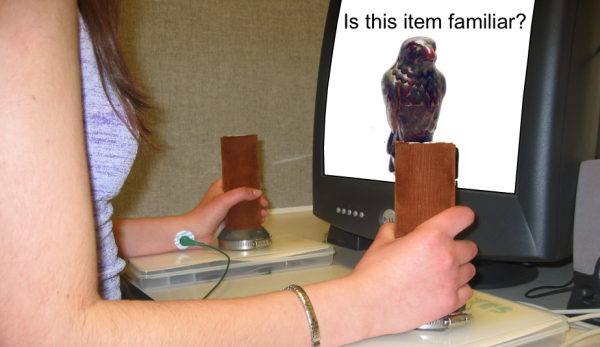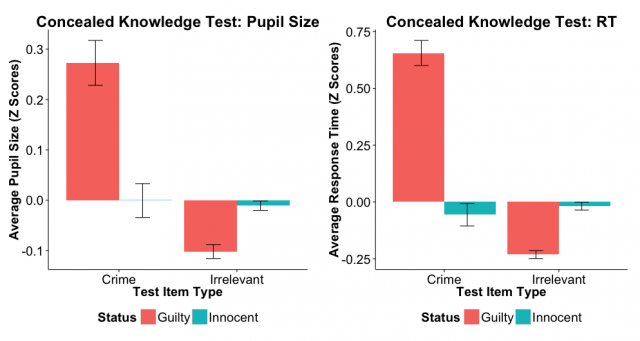
A participant in one of our concealed knowledge experiments. Subjects responded more slowly when denying familiarity of crime pictures, than when truthfully denying familiarity with novel items.
A central problem addressed in our research is how the status of information in memory affects its retrieval. For example, if you tell a lie, will the memory for that lie operate in the same way as for truths you told at the same time? Traditional “lie-detector” polygraphy (e.g., using heart rate, respiratory rate, and sweating) is an effective interrogation tool (produces a higher confession rate), but is a poor method for identifying lies (National Research Council, 2003). An alternative approach measures the recognition of information, rather than lying per se. These Guilty Knowledge Tests (GKT) use a polygraphy paradigm where responses to presentations of crime-related and control stimuli are compared. The assumption is that recognizing crime-related items will lead to feelings of anxiety, and in turn larger physiological responses. Recent variations have included measures such as pupil dilation and brain activation in regions known to be associated with recognizing personally significant stimuli. Unfortunately, such tests can be expensive and cumbersome to implement. Furthermore, it is not clear if the “guilty” nature of crime information in memory is critical to successful detection using the GKT.
Our work in this area has identified a measure based upon how long it takes someone to respond to crime information. Previous recognition memory research demonstrates that while responses based on familiarity alone can be made quickly, responding to some familiar items and ignoring others is slower. Inspired by this work, we developed a research paradigm to examine the effects of having participants perform categorizations under fast response deadlines. In this paradigm, participants commit a mock-crime and then memorize a set of benign target items. Later, in a speeded test, their recognition of these items is measured. They are asked to truthfully respond “Yes” to familiar target items, and deceptively respond “No” to familiar crime items, as well as new unfamiliar filler items. Despite their attempts to conceal their knowledge of the crime items, participants’ deceptive responses to this information are consistently slower and less accurate than to filler items (Seymour, Seifert, Shafto, & Mosmann, 2000). This test, accompanied with a novel analysis technique, produced a significantly higher detection rate (94%-98%) than was typical with polygraph-based GKTs, and a very low false positive rate (0%-3%). We proposed this (low cost) response time paradigm as a viable alternative to the GKT and polygraph-based “lie-detectors.”

More recently, we have explored the applied viability of this paradigm, as well as the underlying cognitive mechanisms involved. For example, does the type of information (e.g., verbal, vs. visual), or its status in memory (e.g., emotional vs. benign) influence one’s ability to conceal their knowledge of it? In one study, we showed that my reaction time paradigm was successful using pictures of faces (Seymour & Kerlin, in 2008). Because we found identical reliability for tests of phrases and faces, these results also suggest that the cognitive mechanisms underlying our test are not peculiar to verbal memory. This is also important because most deception studies have focused on verbal stimuli despite the increasing use of photographic evidence during trials and interrogations. This study also found nearly identical results from tests based on mock-crimes and those from benign learning protocols. This suggests that the test’s effectiveness is less dependent on the special status of crime items in memory than previously thought.
In another study, we examined whether the richness of information in memory influences our ability to detect it. For example, some recent court cases using the GKT paradigm used peripheral crime scene details (such as the height of grass growing at the scene) as test items whereas in other cases central items (such as the murder weapon) were used. We found that for tests given immediately after the crime, both types of items are effective, but after long delays, only central crime details lead to accurate classification (Seymour & Fraynt, 2009). Although tests using central items are unaffected by time, those using peripheral items approach chance performance after one week. Finally, in response to previous work suggesting that RT-based tests may be more susceptible to countermeasures than more traditional psychophysiological measures. We have completed new in which we compare the influence of explicit countermeasures on the detection efficiency of RT and skin conductance based GKTs. I found that overall both tests performed equally well and were only minimally attenuated by the countermeasure. However, the skin conductance effect habituated more quickly than with RTs.
We have recently completed work on an extended study comparing ocular and manual measures of concealed knowledge (Seymour, Baker, & Gaunt, 2013). The project examines the potential of simultaneous measures of blinking, pupil size, and response times to detect concealed knowledge. In previous studies, accuracy of ocular measures has been poor and inconsistent, but we found strong classification accuracy for both the ocular and response time measures. This work is the first to combine ocular and response time measures for multimodal lie detection. This approach leads to higher detection rates than using either measure in isolation (except RT, which was already near 100%). The potentially controversial possibility of using covert pupil measures without a participant’s awareness was also examined. We found that the pupil effect is highly dependent on the response, casting considerable doubt on the possible success of its covert use.